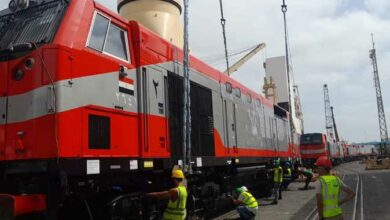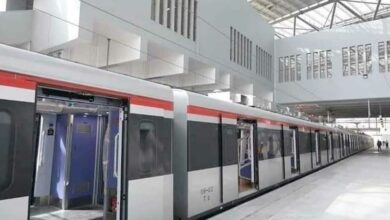
The exhibition space at Artellewa is not typical of white-cube galleries. It may be, technically, a white cube, but the tiny, street-level space functions almost as just another storefront nestled into a crowded Ard al-Lewa street.
The space is uniquely integrated into its surroundings, but this quality is not always something that exhibiting artists choose to incorporate into their work. But “Shubra Line,” a new, collaborative installation by Yara Mekawei and Mina Nasr, interacts in strange and surprising ways with the setting and the sounds of the street. With “Shubra Line,” Nasr and Mekawei recreate a distinct Cairo location in a separate and equally distinct location, causing both integration and disjuncture as their created metro space blends into and clashes with the streets of Ard al-Lewa. The project is simple, but its use of the space is effective.
Mekawei’s and Nasr’s intent was straightforward: to recreate one space in Cairo and place it into another space. Mekawei told Egypt Independent, “I just wanted to move some of the ambient sound from space to space. … When you hear these special sounds outside the metro, it takes you back inside the metro station.”
“Shubra Line” does this beautifully and effectively. As an installation, it transforms the given space. But constant sonic reminders of the surrounding neighborhood flow into the small square of the Artellewa gallery. A passing garlic seller’s amplified voice momentarily overwhelms the sound coming from the exhibition. Tuk tuks rattle by, mirroring the sound of the metro itself, and it all mixes together in a dissonant harmony.
The installation is cleverly arranged so that sound comes out of various speakers, positioned on the faces of passengers, drawn by Nasr. Two men on one wall have a conversation that projects from round, black speakers that cover their faces. Later the sound moves to another wall and another pair of men.
Mekawei herself is primarily a sound artist and electronic musician. She and her partner, Ola Saad, make up RGB, an electronic music group that performed in 2011 as a part of the 100 Live Electronic Music Festival last spring. The project similarly seeks to use sound to evoke images. Mekawei told Egypt Independent at the time that “the intent is for you to see light,” and not to make music.
In this case, the intent is for you to feel yourself on the metro.
Mekawei mostly collected sounds from within the metro, like music playing from cellphones, ambient chatter and wheels rumbling over train tracks. But for the audible conversations, she refers to an earlier work about life on public transport, borrowing from the 1979 Adel Imam film “We are the Bus People.” Mekawei chose this particular dialogue because she felt that it accurately mirrored the conversations that people might be having today on the metro, about politics and a changing country.
“When you hear this small conversation, recorded in the 1980s, you feel it is the same situation now in Egypt. They talk about the government, and the president, and the Parliament. These are the problems that we live,” says Mekawei.
The collaboration between Mekawei and Nasr is clean and simple, and fits ideally into the work that both artists were doing independently, using their respective mediums to recreate elements of life in the city.
Nasr has done a number of works that involve wall drawings, and with “Shubra Line” he carries on in the style of his last work to be exhibited, a life-size line of Egyptians waiting to vote for the first time, which was on display as a part of “Visionary Africa: Art at Work,” at Al-Azhar Park in February.
“Shubra Line” is a continuation and reapplication of the piece included in “Art at Work.” Nasr again draws life-size humans, standing side by side, this time crowded together in a metro car. A few women hover in the crowd, as one man reads a Quran and another sleeps on a bench, clinging to a backpack. Still others stand listlessly, gripping the handles that hang from the ceiling. They have tired, detached faces attached to tired bodies, all situated a little too close for comfort.
The effect is not quite that of being inside the metro car. It is more like an eavesdropper’s dream: the opportunity to watch life on the metro without crowding into a steaming cabin. From the center of the tiny square gallery, the metro is a quiet space where everyone minds his own business.
On one of her first visits to Artellewa, Mekawei was surprised to find, in conversing with a young woman who asked her how she got to the neighborhood, that the woman had never ridden the metro. The conversation acted as a reminder of how separated Cairo’s many vast neighborhoods can often become. With “Shubra Line,” Mekawei and Nasr bring one of the great common spaces of the city into a place where it has not existed before.
“Shubra Line” is exhibited at Atrellewa until 24 April.





